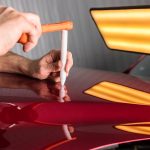Hailstorms are a natural phenomenon that can cause significant damage to property and vehicles. Understanding how hail forms, the different sizes of hailstones, and their impact on vehicles can help you better prepare and protect your car. In this post, we’ll dive into the science behind hail formation, the potential damage it can cause to vehicles, and tips on how to safeguard your car during a hailstorm.
How Hail Forms
Hailstones are formed within strong thunderstorms that have intense updrafts, abundant moisture, and a particular temperature structure. Here’s a step-by-step breakdown of the process:
- Formation of Thunderstorms: Hailstones begin as water droplets in a thunderstorm. The updrafts within the storm carry these droplets upward into extremely cold areas of the atmosphere.
- Supercooling: As the droplets are carried higher, they encounter temperatures below freezing and become supercooled, meaning they remain in liquid form even below 32°F (0°C).
- Nucleation: Supercooled droplets freeze upon contact with dust particles or other ice nuclei, forming small ice pellets.
- Growth: These ice pellets are carried up and down within the thunderstorm by the updrafts. As they move, they collide with supercooled droplets, which freeze upon impact, causing the hailstones to grow in layers.
- Descent: Once the hailstones become too heavy for the updrafts to support, they fall to the ground as hail.
Different Sizes of Hailstones
Hailstones can vary greatly in size, from small pellets to large, destructive balls of ice. The size of hailstones is influenced by the strength of the updrafts in the storm and the length of time they remain in the updraft cycle. Here are some common sizes:
- Pea-sized hail: About 0.25 inches in diameter.
- Marble-sized hail: About 0.5 inches in diameter.
- Dime to quarter-sized hail: About 0.75 to 1 inch in diameter.
- Golf ball-sized hail: About 1.75 inches in diameter.
- Tennis ball-sized hail: About 2.5 inches in diameter.
- Baseball-sized hail: About 2.75 inches in diameter.
- Softball-sized hail: About 4.5 inches in diameter.
Impact of Hail on Vehicles
The damage hail can cause to vehicles depends on the size and density of the hailstones, the duration of the hailstorm, and the exposure of the vehicle. Here are some common types of damage:
- Dents and Dings: Smaller hailstones can cause minor dents and dings on the vehicle’s body panels. While these may seem cosmetic, they can reduce the vehicle’s resale value.
- Cracked Windshields and Windows: Larger hailstones can crack or shatter windshields and windows, posing a safety hazard.
- Damaged Paint: Hail can chip or scratch the paint, leading to rust and corrosion if not repaired promptly.
- Broken Lights and Mirrors: Hail can also damage headlights, taillights, and side mirrors, requiring replacement to ensure safety and functionality.
How to Spot Paint Damage from Hail
Identifying paint damage from hail requires a keen eye and a methodical approach. Here are some tips to help you spot such damage:
- Inspect for Dents and Chips: Severe dents are often accompanied by paint damage, but even minor dents can result in chipped or cracked paint. Don’t overlook small dings.
- Examine the Clear Coat: Check for inconsistencies in the vehicle’s shine. If the clear coat is compromised, areas might appear dull or uneven.
- Check for Scratches: Hail driven by wind can cause scratches, especially on the sides of the vehicle. Look for horizontal or diagonal marks.
- Use the Right Lighting: Inspect the vehicle under natural sunlight or use a bright flashlight to reveal hidden imperfections.
- Feel for Rough Spots: Run your fingers gently over the surface. Rough or uneven areas may indicate paint damage.
What to Do If Your Vehicle Is Exposed to Small Hail
Before the Hailstorm Hits:
- Seek Shelter: Park your vehicle in a garage or under a carport.
- Use a Car Cover: Invest in a high-quality hail-resistant cover.
- Find Wind Protection: Park beside a sturdy building to shield from wind-driven hail.
During the Hailstorm:
- Stay Inside: Prioritize your safety during the storm.
After the Hailstorm:
- Inspect for Damage: Look for dents or cracks in the glass.
- Document Damage: Take photos for insurance claims.
- Contact Your Insurance: Report hail damage promptly.
- Seek Professional Repair: Choose a service like US Hail Repair to restore your vehicle.
How Quickly Should You Get Your Vehicle Fixed After a Hailstorm?
Act Fast to Prevent Further Issues
Delaying repairs can lead to more extensive damage, such as rust or paint deterioration. The sooner you address the damage, the better.
Insurance Coverage Simplifies the Process
Most insurance policies cover hail damage. Prompt action can streamline the claims process and reduce out-of-pocket expenses.
Efficient Repair Services Available
Many specialized repair shops, like US Hail Repair, offer fast turnaround times, some within 48 hours, to get your vehicle back on the road quickly.
Why Prompt Repairs Matter
- Prevents Additional Damage: Addressing hail damage quickly prevents it from worsening.
- Insurance Efficiency: Early repairs can speed up insurance claims.
- Resale Value: Maintaining your vehicle’s condition helps preserve its resale value.
Conclusion
Understanding the science of hail formation and its impact on vehicles can help you better prepare and protect your car from potential damage. By taking preventive measures and staying informed about weather conditions, you can minimize the effects of hail on your vehicle. If your car does sustain hail damage, consider professional services like Paintless Dent Repair (PDR) to restore it to its pre-storm condition while preserving the original paint and finish.
For more information or to schedule a repair, contact US Hail Repair today, and let our experienced team help you get your vehicle back to its best condition.



